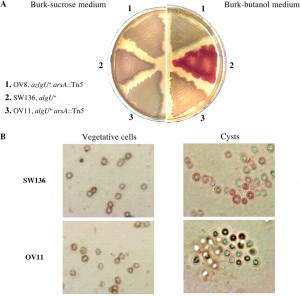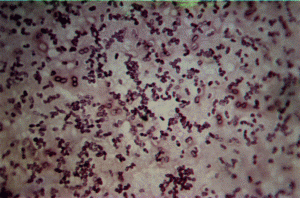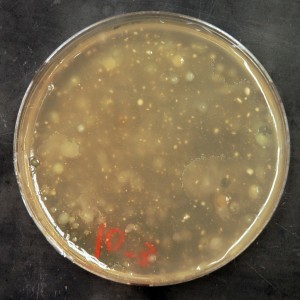 Azotobacter is a genus of usually motile, oval or spherical bacteria that form thick-walled cysts and may produce large quantities of capsular slime. They are aerobic, free-living soil microbes which play an important role in the nitrogen cycle in nature, binding atmospheric nitrogen, which is inaccessible to plants, and releasing it in the form of ammonium ions into the soil. Azotobacter species are Gram-negative bacteria found in neutral and alkaline soils, in water, and in association with some plants.
Azotobacter is a genus of usually motile, oval or spherical bacteria that form thick-walled cysts and may produce large quantities of capsular slime. They are aerobic, free-living soil microbes which play an important role in the nitrogen cycle in nature, binding atmospheric nitrogen, which is inaccessible to plants, and releasing it in the form of ammonium ions into the soil. Azotobacter species are Gram-negative bacteria found in neutral and alkaline soils, in water, and in association with some plants.
Cysts of the genus Azotobacter are more resistant to adverse environmental factors than the vegetative cells; in particular, they are twice as resistant to UV light. They are also resistant to drying, ultrasound and gamma and solar irradiation, but not to heating.
A cyst of the genus Azotobacter is the resting form of a vegetative cell; however, whereas usual vegetative cells are reproductive, the cyst of Azotobacter does not serve this purpose and is necessary for surviving adverse environmental factors. Following the resumption of optimal environmental conditions, which include a certain value of pH, temperature, and source of carbon, the cysts germinate, and the newly formed vegetative cells multiply by a simple division. During the germination, the cysts sustain damage and release a large vegetative cell.
Germination of cysts, a slow process, takes about 4–6 hours. During germination, the central body grows and captures the granules of volutin, which were located in the intima (the innermost layer). Then the exine bursts and the vegetative cell is freed from the exine, which has a characteristic horseshoe shape. This process is accompanied by metabolic changes. Immediately after being supplied with a carbon source, the cysts begin to absorb oxygen and emit carbon dioxide; the rate of this process gradually increases and saturates after four hours. The synthesis of proteins and RNA, occurs in parallel, but it intensifies only after five hours after the addition of the carbon source. The synthesis of DNA and nitrogen fixation are initiated 5 hours after the addition of glucose to a nitrogen-free nutrient medium.
Azotobacter respires aerobically, receiving energy from redox reactions, using organic compounds as electron donors. Azotobacter can use a variety of carbohydrates, alcohols, and salts of organic acids as sources of carbon.
Azotobacter can fix at least 10 μg of nitrogen per gram of glucose consumed. Nitrogen fixation requires molybdenum ions, but they can be partially or completely replaced by vanadium ions. If atmospheric nitrogen is not fixed, the source of nitrogen can alternatively be nitrates, ammonium ions, or amino acids. The optimal pH for the growth and nitrogen fixation is 7.0–7.5, but growth is sustained in the pH range from 4.8 to 8.5. Azotobacter can also grow mixotrophically, in a molecular-nitrogen-free medium containing mannose; this growth mode is hydrogen-dependent. Hydrogen is available in the soil, thus this growth mode may occur in nature.
While growing, Azotobacter produces flat, slimy, paste-like colonies with a diameter of 5–10 mm, which may form films in liquid nutrient media. The colonies can be dark-brown, green, or other colors, or may be colorless, depending on the species. The growth is favoured at a temperature of 20–30°C.
Azotobacter species are free-living, nitrogen-fixing bacteria; in contrast to Rhizobium species, they normally fix molecular nitrogen from the atmosphere without symbiotic relations with plants, although some Azotobacter species are associated with plants. Nitrogen fixation is inhibited in the presence of available nitrogen sources, such as ammonium ions and nitrates.
Nitrogen fixation plays an important role in the nitrogen cycle. Azotobacter also synthesizes some biologically active substances, including some phytohormones such as auxins, thereby stimulating plant growth. They also facilitate the mobility of heavy metals in the soil, thus enhancing bioremediation of soil from heavy metals, such as cadmium, mercury and lead. Some kinds of Azotobacter can also biodegrade chlorine-containing aromatic compounds, such as 2,4,6-trichlorophenol. The latter was previously used as an insecticide, fungicide, and herbicide, but later was found to have mutagenic and carcinogenic effects.




